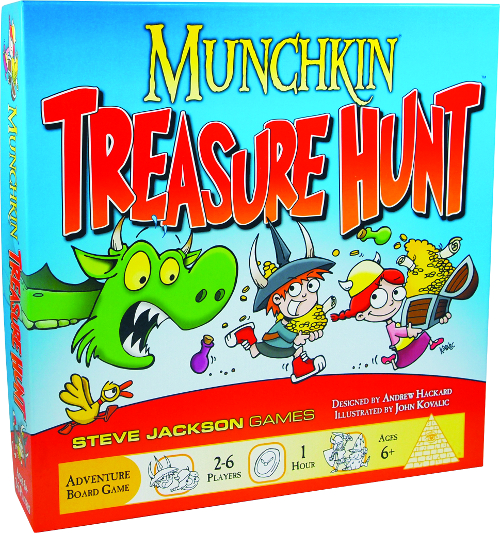
The Basics:
- For ages 6 and up
- For 2 to 6 players
- Approximately 1 hour to complete
Geek Skills:
- Counting & Math
- Logical & Critical Decision Making
- Reading
- Risk vs. Reward
- Semi-Cooperative Play
- Hand/Resource Management
Learning Curve:
- Child – Easy
- Adult – Easy
Theme & Narrative:
- Explore a dungeon and grab loot, Munchkin-style!
Endorsements:
- Gamer Geek rejected!
- Parent Geek approved!
- Child Geek approved!
Overview
The lure of fame and fortune draws many would-be heroes into the dungeon. There, in the darkness, lies adventure and great danger. Gold is what many seek, but the monsters who guard it will fight any who attempt to take it. Armed with tenacity, wit, and the belief that the ever-fickle die will roll your way, you plunge headfirst into the darkness of the dungeon. There you will find your destiny or the business end of a dragon.
Munchkin Treasure Hunt, designed by Andrew Hackard and published by Steve Jackson Games, is comprised of 1 game board, 26 Monster cards, 70 Treasure cards, 2 standard six-sided dice, and 6 cardboard characters with 6 bases. The game also includes 2 blank Treasure and 2 blank Monster cards so you can add a personal touch to the game. The cards are smaller than normal, making it easy for smaller hands (read: Child Geeks) to hold. The game board and characters are thick and durable. The illustrations by artist John Kovalic, of Dork Tower fame, add a whimsical flare to an already visually appealing family game. It’s worth noting that Munchkin Treasure Hunt was purposely designed to be an introduction to the Munchkin card game.
Preparing for Your Dungeon Treasure Hunt
To set up the game, first place the game board in the middle of the playing area and have each player select a cardboard character. Each cardboard character is a different color and shows a boy on one side and a girl on the other. What side the player identifies with is irrelevant. What is important is the color. Each player should also take a base and affix it to the bottom of their cardboard character. When done, players should place their character in the middle of the game board space marked with the title “Entrance”.

Second, shuffle the Treasure cards and deal 3 to each player, face-down. These Treasure cards represent the player’s starting equipment as well as possible points at the end of the game, but only if they don’t use them. The remainder of the Treasure cards are placed, faced-down, on the Treasure space found on the game board. This is the Treasure draw deck for the duration of the game.
Third, shuffle the Monster cards and place them, face-down, on the Monster space found on the game board. This is the Monster draw deck for the duration of the game. When completed, your setup will look similar to the following image
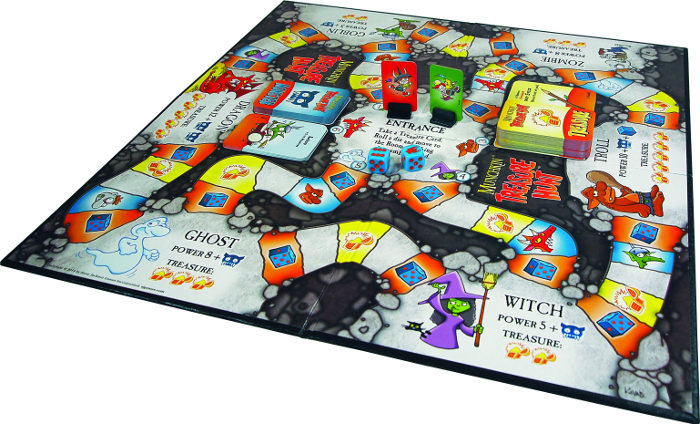
That’s it for game set up. Determine who should go first and begin, young adventurer!
Treasure Tutorial
At the heart of Munchkin Treasure Hunt are the Treasure cards. These provide the player off-the-wall weapons and armor that can be used during the game. However, Treasure also provides the player with Gold which is used to determine the winner at the end of the game. This presents the player with a small problem they must wrestle with throughout the game. Do they keep the Treasure cards for the points or use the Treasure for possibly obtaining more points?
Treasure cards are either “Permanent” or “One-Time”. “Permanent” Treasure cards are played in front of the player and remain active for the duration of the game, giving the player the bonuses it provides. A maximum of 2 “Permanent” Treasure cards can be in play at a time. A player is always welcome to swap one “Permanent” Treasure card for another one, but doing so causes the replaced “Permanent” Treasure card to be discarded. When a “One-Time” Treasure card is used, it goes to the Treasure discard pile. There is, however, a Treasure card that allows a player to quickly snatch back a used Treasure card.
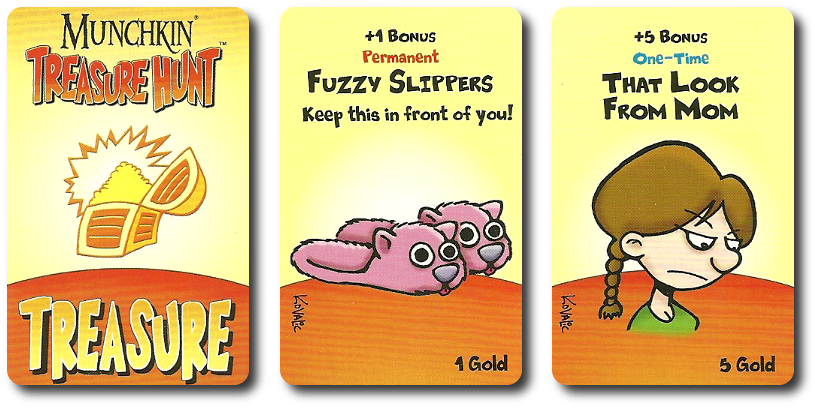
I know that “look”, by the way…
Players are dealt 3 Treasure cards at the start of their turn. Before the game begins or during their turn, the player can play as many Treasure cards as legally possible. Players should remember, however, that every Treasure card played means less Gold for winning the game.
Kicking Monster Butt and Taking Gold
Munchkin Treasure Hunt is played in turns with no set number of turns per game. A player’s turn is summarized here.
Step 1: Roll for Movement
The first thing a player does is roll 1 six-sided die and then moves that many spaces in any direction they like. Players move in one single direction, however, and must stop if they ever enter a “Room”. There are 7 rooms in total that are connected by hallways. Six of the rooms hold a monster (goblin, dragon, ghost, witch, troll, and zombie), and the final room is the entrance where the players started.
Note: All players start in the Entrance room. A player ignores the rules of the Entrance room until they leave it for the first time. From thereon out, the rules of the Entrance room are followed by the players.
Step 2: Encounter Space
Traveling about the dungeon is risky business. Around every corner could be treasure or a monster looking to clobber you. When a player moves, they will run into the following.
Hallways
If the player ended their movement in the hallways (the spaces that connect the different rooms), they will land on 1 of possible 4 spaces.
- Roll Again (image of a die): If the player ends their movement on this space, they roll the dice and move again.
- Treasure Chest: If the player ends their movement on this space, they draw 1 Treasure card and add it to their hand.
- Blank: Nothing here. The player’s turn now ends.
- Monster Space (face of monster): If the player ends their movement on a space that has a picture of 1 of the 6 monsters, they take their character and move it to the Monster’s room. They must now fight the monster.
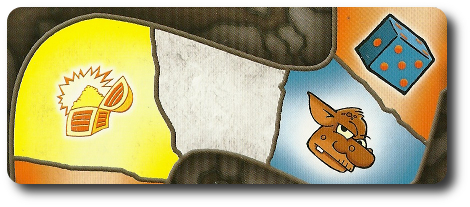
The Entrance
If the player ends their turn in the Entrance room, they take 1 Treasure card and add it to their hand in the same way a player adds a treasure if they land on the Treasure space. They then take a die and roll it. The number rolled signifies which of the Monster rooms the player immediately relocates to. They must now fight the monster.
Monster Rooms and Combat
Each Monster room will list the following information.
- Monster’s Name
- Monster’s Base Power + Bonus
- Treasure Reward
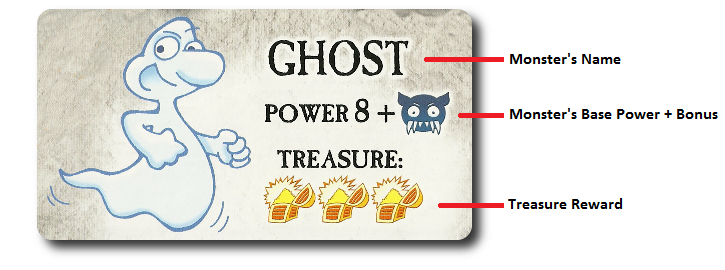
The name of the monster is purely thematic. What is not is the Monster’s power. Each Monster has a base power number followed by 1 or 2 Monster card icons and possibly a six-sided die. The Monster card icons indicate how many Monster cards should be drawn when encountering the Monster room (1 icon equals 1 card, 2 icons equals 2 cards). The Monster cards add additional power to the Monster’s base, as well as adding funny adjectives to the Monster’s name. “Big-Eared” Ghost, for example. If the die icon is shown, the die is rolled and the rolled value is also added. The total of the Monster’s power base, plus any Monster card and die rolled values, equals the Monster’s total power.
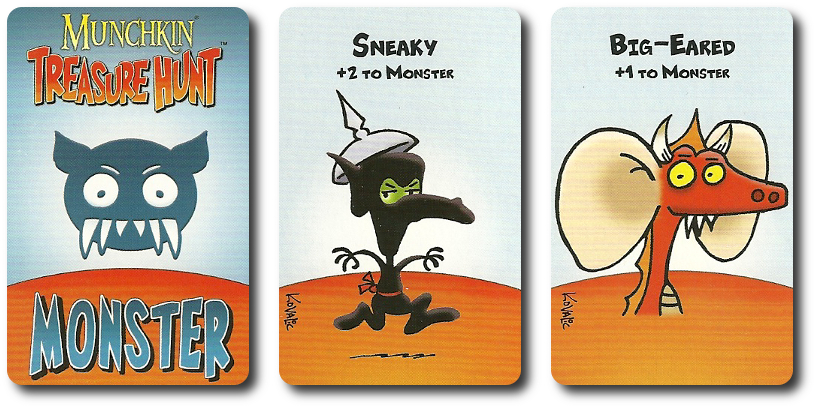
Now the player attempts to roll a value equal to or higher than the Monster’s total power. Oftentimes, this is impossible if only rolling a single six-sided die. Lucky for the player, they have Treasure cards. The player can now play as many (or as few) as they like to give them bonus power. Remember that only 2 “Permanent” Treasure cards can be used at a time, but there is no limit to the number of “One-Time” Treasure cards. The player then rolls the six-sided die, adds the rolled value to any bonus power provided by treasure, and that is the player’s total power.
The player can also ask for help, but must do so before rolling to fight the monster. Any opponent who has a character within 6 spaces of the Monster room the player is currently located in is a possible helper, but only if they agree. If they do agree, helper opponents roll a die and add their bonus power from Treasure cards. The helper opponent could even play “One-Time” Treasure cards if they like. The total power from the helper opponent is added to the player’s total power. Only 1 helper opponent can assist the player, but the player is welcome to ask any opponent they like that is within 6 spaces.
Running Away or Grabbing Loot
If the player’s total power is lower than the Monster’s total power, they have been defeated. They must now run away, which is the correct thing to do when a monster is clearly the victor. The player rolls a six-sided die and moves that many spaces away from the Monster room. Regardless of what space the player ends their turn in, it’s treated as a “Blank”. The player then discard one “Permanent” Treasure card that is in play (player’s choice). If none are available, the player discard 1 Treasure card of their choice from their hand. Helper opponents do not run (they stay in the room) and do not discard a Treasure card.
If the player’s total power (from the die value, bonuses, and helper opponent’s total power) is equal to or higher than the Monster’s power, they are victorious! They now draw 1 Treasure card for every Treasure Chest that is listed in the Monster room. These are taken into he player’s hand and can be equipped if the player has “Permanent” Treasure card they want to play now. Note that a player never needs to show what Treasure cards they have drawn. With one exception…
If the player was helped, the Treasure cards that are drawn are shown to everyone playing the game. The helper opponent then gets to take 1 Treasure card that was drawn with any remaining being claimed by the player.
Regardless of the outcome of battle, the used Monster cards are placed in the discard pile. If the Monster draw deck is ever exhausted, shuffle the discard pile to make a new draw deck.
King of the Dungeon
The game ends when the last Treasure card is drawn. All the players now add the total Gold value of the Treasure cards in their hand. Any “Permanent” Treasure cards in play are not counted. The player who has accumulated the most Gold wins the game! Players who are tied share the victory.
House Rules
Treasure Hack
After playing the game several time, the Child Geeks had a suggestion on how to make the game even more fun. First, players can have as many “Permanent” Treasure cards as they like. None of this “Limit of 2” nonsense. Second, when a “Permanent” Treasure was discarded, it went to the bottom of the Treasure draw deck instead of the discard pile. I don’t suggest this House Rule, but the Child Geeks really like it.
To learn more about Munchkin Treasure Hunt, visit the publisher’s website.
Prediction
Since this is based on the popular (depending on whom you ask) card game, Munchkin, is light, fairly fast to play, and has a semi-cooperative element to it, I think Munchkin Treasure Hunt will be greatly appreciated by the Child Geeks and enjoyed by the Parent Geeks. This has “family game” written all of over. More to the point, this game was purposely designed to be an introduction to the Munchkin card games for those younger players who cannot yet grasp the essentials. That’s going to be happy news for both Child Geeks and their Parent Geeks who have one or more sets of Munchkin in their home game collection.
But the same cannot be said for the Gamer Geeks. Gamer Geeks tend to either think the game is so-so or flat-out dislike Munchkin. The most elite of gaming elitists will even go so far as to jump on a sandbox and tell you how wrong everything is in the world thanks to the Munchkin card game. I wish I was making it up, but I witnessed a geek rage session focused on Munchkin and how it would bring about the fall of the gaming hobby. Total nonsense. I think the game is a fun one and has brought the gaming hobby to more gaming tables. Which is exactly what we want. More players means more games.
Cleary, everyone has an opinioin and some like to make it more known than others. But for this game, I think the Gamer Geeks will quietly say “no thank you” or go off on a tirade about how I wasted their time. Which I might be, but we don’t know until we try.
Teaching Munchkin Treasure Hunt is best done by walking each player through their turns until they can do it on their own. The choices in the game are fairly limited, but a younger player can still feel overwhelmed at first. Break each turn down and be patient. Younger players might take a turn or 2 to get the game, but everyone else will understand how to play the game after watching the first turn.
I also suggest that you allow players to place their Treasure cards face-up in front of them. Make two rows of cards. The row closest to the player is their “hand” and the 2 cards in front of them and any “One-Time” Treasure cards used represent the played cards. This allows the younger players to keep an eye on all their cards and the older players to make helpful suggestions. The only reason you’d want to keep your Treasure cards hidden is to make certain opponents don’t know how much Gold you have, but that level of competitive paranoia is not necessary when playing with the Child Geeks. At least not until after the first game.
Note that players do need to know how to read and to do simple math in this game. Again, I suggest you have players place their cards in front of them, face-up. This will help older players quickly add bonus power values for the younger Child Geeks. Doing so will also help keep the game going at a fast pace.
And so, after teaching Munchkin Treasure Hunt to my 3 little geeks, I asked them their thoughts on the game so far.
“Oh, this is based on the card game. Awesome.” ~ Liam (age 10)
“Sounds simple and fun. I like the crazy treasures you can win.” ~ Nyhus (age 7)
“I want to fight the zombie and the dragon! Not the witch.” ~ Ronan (age 4)
My oldest has played Munchkin several times, while his two younger brothers have not. All of them think the game looks neat and the game play is pretty straightforward. I doubt that my 4-year-old will play the entire game, but I’m excited to see him try. Let’s jump into the dungeon and see if we find treasure or nothing but a pile of dragon dung.
Final Word
The Child Geeks really enjoyed themselves, with the older Child Geeks getting a bit upset that there weren’t more “Permanent” Treasure cards to be won and the ever-fickle die did not “rolling right”. One aspect of the game play that all the Child Geeks enjoyed was the ability to call for help. For those who had played the Munchkin card game, they liked that they were able to plunder some of the treasure after offering a helpful hand. For those who had not, they liked that they didn’t have to face the dangers of the dungeon alone. According to one Child Geek, “I like this game. Finding treasure is so cool!” An older Child Geek said, “I think I like the card game better, but I can play this with my friends.” An excellent point. Those Child Geeks who know how to play the card game are not the intended audience for this game. Finally, and as expected, our youngest player at age 4 played the game for about 20 minutes, got bored, and wandered off to play with his toys. Everyone else stayed at the table and agreed that Munchkin Treasure Hunt was a good time.
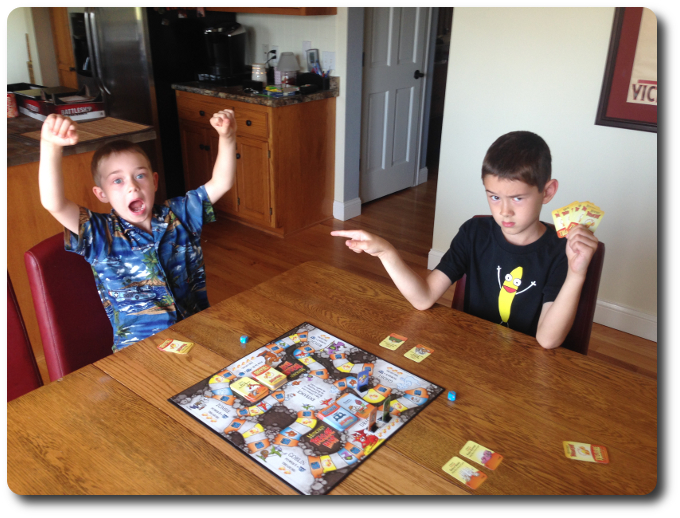
My little geek shouts for joy after defeating the DRAGON!!!!! (with his dad’s help)
The Parent Geeks were either overjoyed or simply OK with the game. The Parent Geeks who were overjoyed turned out to be big fans of the Munchkin card game. According to one Parent Geek, “I think it’s great that they made a family game set in the Munchkin world you can play with the younger players.” Another Parent Geek said, “This is a great game to introduce simple hand management, risk management, and critical thinking. Plus, it also introduces players to Munchkin!” Those Parent Geeks who didn’t know anything about Munchkin or didn’t care for the game, found Munchkin Treasure Hunt to be a “good game for the family table”. According to one Parent Geek who wasn’t all that excited bout the game, “I would play this with my kids and with their friends, but this isn’t a game I’d play with just adults.” When all the Gold was counted and the game put away, the Parent Geeks all agreed the Munchkin Treasure Hunt was worth playing again with their family.
The group of Gamer Geeks who enjoyed or tolerated Munchkin had no issues with Munchkin Treasure Hunt but didn’t think it was a game they would endorse for Gamer Geeks. According to one such Gamer Geek, “This is a good game for the kids and for families. I think it does a pretty good job and there are some interesting choices to make, but the game is way too simple for advanced players. Plus, it uses the roll-and-move game mechanism, which I think is absolutely horrible.” Ah, yes, the old roll-and-move. Just one of the many things gaming elitist dislike. That and spinners. Another Gamer Geek said, “This is not a Gamer Geek’s game. This is a casual gamer’s game who has a family.” To the point! I like that. Finally, one Gamer Geek got really bothered by this game and said, “I don’t hate this game, but I hate what it’s about. It doesn’t dumb itself down as much as other family or child games, but I don’t like how simple it is. I know kids can play more complicated games and have a good time. Where the hell is the challenge here? I think it fails.” In the end, the Gamer Geeks all agreed that Munchkin Treasure Hunt was not a game for them or other gaming elitists.
As an avid gamer who enjoys playing a stupidly wide variety of games, I am always excited to sit down with family members and geek out with them. I’m lucky in the sense that I don’t much care about what we play, but I’d be lying if I suggested I like every game. There are a number of games my little geeks want me to play with them that I cannot stand. I put on a “happy face” for their sake and work through it. I never felt like I was faking my enthusiasm while playing Munchkin Treasure Hunt. Yes, it’s simple. Yes, it can feel repetitive at times. And, yes, it’s a watered down version of the card game. But you should see how involved by kids get when it’s their turn or when they cheer on the other players when they are about to take on a monster. The game creates great energy at the gaming table and it was easy to get caught up by it.
The board game is not a replacement for the card game, but it’s an excellent stepping stone. After playing the board game, my two oldest little geeks wanted to play the card game version, which we promptly did. Up until then, my middle child didn’t express any interest. After the board game, he now enjoys the card game more. A perfect example of how Munchkin Treasure Hunt acts a gateway to more games. Or in this case, specific games.
Of course, if you dislike Munchkin, this isn’t the game for you, but it might be the game for your family and your kids. Who knows? You just might start to like Munchkin. Do give it a play or two with your Child Geeks and see if the game provides a fun adventure for the family.
This game was given to Father Geek as a review copy. Father Geek was not paid, bribed, wined, dined, or threatened in vain hopes of influencing this review. Such is the statuesque and legendary integrity of Father Geek.




Pingback: In Review: Father Geek’s Monthly Newsletter (September 2014) - Father Geek
Pingback: Munchkin TREASURE HUNT